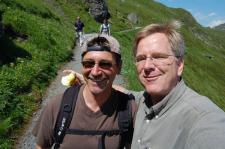Filming a TV show in Burgundy this week has caused me to think a lot about the French. The great issues of the day seem to deal with food and drink.
Take the sad story of snails. Good escargot must grow wild. But as effective chemicals have successfully killed off weeds and undesirable insects, they have also decimated the slug and snail populations. These days in France, much of the escargot is farmed. Locals know the grey snails are farmed and mediocre at best.
 |
|
Enlarge photo |
Perhaps the snail is to France what the buffalo is to America. The great French snail — once so common that early-19th-century train companies hired women and children to clean the tracks of them so the trains could get a grip — has gone the way of the great American buffalo. I hate to burst any bubbles…but if you’re slurping top-quality “free-range snails” in a little Paris bistro, they most likely last slithered free in Poland.
The French, in an attempt to cut back on farming chemicals, are resorting to “sexual confusion.” Farmers use an organic spray that covers everything with the scent of a female insect. Male insects smell females, find nothing, get mad, and in their sexual funk…refuse to reproduce.
Wine is another topic that arouses the French. Walking through the finest vineyards in France, the fabled Côte d’Or (or “Golden Hillside”) of Burgundy, an elegant vintner evangelizes:
“A good grape must suffer. Look at this soil — it’s horrible…just rocks. And these grapes have character. The roots of these struggling vines are thin as hairs, searching as much as 30 meters down for moisture. The vines in the flat fields” — she motions to fields just a kilometer away — “have it too easy…a silver spoon in their teeth. It’s like people. Paris Hilton, she is not interesting. The fine wines of humanity, they are the ones who have suffered.” (I found myself comparing Paris Hilton and Tina Turner.)
“The best vintners don’t force their style on the grape. They play to the wine’s strength, respecting the natural character of the sun, soil, and vine…the terroir.They play the wine like a great musician plays classical music. You don’t want to recognize the musician…you want to hear Beethoven.”
After biking through the idyllic vineyards, where road signs read like a list of fine wines, I was determined to film a restaurant set in a vineyard. Steve and I had enjoyed a place called Le Relais de la Diligence. Two years ago, the vines were lapping at its tables. Today, it’s in a wheat field. With the whole world making good wines, the French are cutting back on quantity, using marginal land for other crops, and working to build the quality.
The next restaurant we tried was aghast that we would even think of filming there. It was a matter of discretion…as if most of their clientele were enjoying affairs. (Only in France is this a major issue in restaurants. Even so, wherever we film in restaurants, we politely visit with each table and confirm that they are okay being shown on TV.)
I have long thought there was something affected and pseudo-sophisticated about all this finicky French culture. While buying wine, you ask what would be good with escargot, and the wine merchant needs to know how you plan to cook the snails. I envisioned a good Chardonnay…oh, you’re cooking it that way? Then you need something flinty — a Chablis.
Then I thought of the way I (or someone who pooh-poohs the French passion for fine points in cuisine) might celebrate the nuances of baseball. Take a Frenchman to the ballpark. All the stuff that matters to me — how far the runner is leading off first base, who’s on deck and how he does against left-handed pitchers, how deep is the bullpen, put in a pinch runner! — would be nonsense to him.
The next time I put a little ketchup on my meat and my French friend is mortified, I’ll just remember that with two outs and a full count, he’ll have no idea why I know the runner’s off with the pitch.







